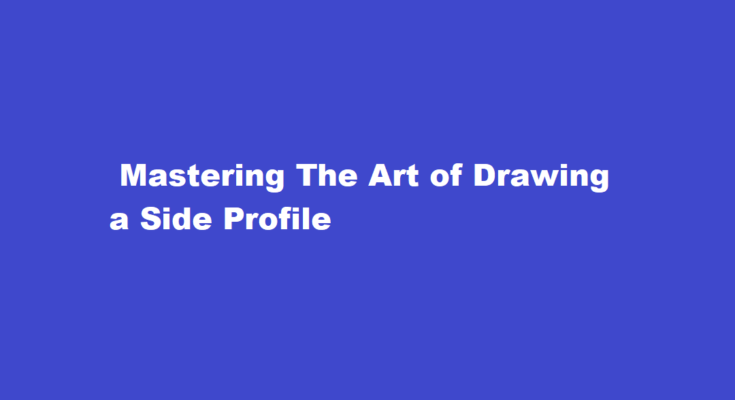The human side profile is a fascinating subject for artists. It provides a unique perspective that showcases the intricate details of the face from a distinct angle. Whether you’re a beginner or an experienced artist, capturing a side profile can be both challenging and rewarding. In this article, we will explore the key steps to help you master the art of drawing a side profile.
Understanding the Basics
Before you start sketching, it’s essential to understand the basic proportions of the human face. The average human head can be divided into thirds: the hairline to the brow, the brow to the base of the nose, and the base of the nose to the chin. These divisions serve as a foundation for your side profile drawing.
Tools and Materials
Gather your drawing tools, including a variety of pencils (ranging from H to B), an eraser, a sketchbook or drawing paper, and a blending tool (like a blending stump or your fingertip). Using a good quality paper can make a significant difference in your drawing.
Observational Skills
Developing your observational skills is key to accurately capturing a side profile. Study reference images, observe real-life subjects, and take note of the subtle nuances in their features. Notice how the nose, lips, and chin align, and how the ear connects to the head.
Starting with a Basic Outline
Begin by lightly sketching a simple oval shape to represent the head. This oval serves as the foundation for your side profile. Next, draw a vertical line down the center of the oval. This line will act as a guide for aligning the features.
Nose and Lips
The nose and lips are central elements of a side profile. Start by sketching the nose’s basic shape, ensuring it aligns with the centerline. Pay attention to the bridge of the nose and the nostrils’ curvature. Then, carefully outline the lips, noting their thickness and shape.
Eyes and Eyebrows
Position the eyes along the centerline, ensuring they are evenly spaced and aligned with the nose. Draw the basic eye shapes, including the upper and lower lids. Add detail to the irises and pupils, and don’t forget the eyebrows, which should follow the brow bone’s contour.
Ears
The ears should be drawn in proportion to the head. They typically start at the browline and end near the base of the nose. Observe the shape and placement of the ears in your reference, and carefully replicate them.
Hair and Neck
Determine the hairstyle and the neck’s position based on your reference or your artistic interpretation. Remember that the neck should connect smoothly to the base of the head, not appearing disjointed.
Adding Shadows and Highlights
The play of light and shadow is crucial for creating depth in your side profile drawing. Observe your reference or imagine a light source, and add shadows accordingly. Use a range of pencils to vary the depth of shading, from light to dark. Pay attention to the shadows under the nose, the lips, and the chin. Conversely, highlight areas like the forehead, nose bridge, and cheekbones.
Blending and Refining
Use a blending tool or your fingertip to blend and smooth the transitions between shadows and highlights. This technique adds a more polished and realistic appearance to your side profile.
Erasing and Correcting
Don’t be afraid to erase and correct any mistakes or inconsistencies in your drawing. The eraser is a valuable tool in the artistic process, allowing you to refine your work.
Fine Details
Now, focus on refining the smaller details of the side profile. Add subtle lines to indicate skin texture, and pay attention to fine details like wrinkles, freckles, or moles if they are present in your subject.
Final Touches
Step back and assess your drawing as a whole. Make any necessary adjustments to ensure accuracy and balance. Take your time to make the final touches that bring your side profile to life.
Practice
The key to mastering the art of drawing a side profile, like any art form, is practice. Continuously work on improving your skills by sketching different side profiles, experimenting with various features and expressions.
FREQUENTLY ASKED QUESTIONS
What is a pretty side profile?
The most attractive side profile for most people is either a straight profile or a profile that has a bit of a scoop. Females tend to prefer a slight scoop over males who go for a straight profile. What it really comes down to though, is personal preference.
Are side profiles hard to draw?
Profiles can feel extremely tricky to draw because of all the angle variations that make us who we are as individuals. For example, in the photo above – I’ve highlighted the angle of the nose to the chin to show you just how much this changes from face to face.
In conclusion, drawing a side profile can be a challenging but immensely rewarding artistic endeavor. By understanding the basics of proportions, honing your observational skills, and practicing regularly, you can master this unique angle and create captivating side profile drawings. Remember that every artist has a distinct style, so don’t be afraid to experiment and develop your personal approach to capturing the human side profile. With dedication and practice, you can refine your skills and produce striking, lifelike representations of the human face in profile view.
Read Also: A Step-by-Step Guide on How to Reset Your Apple Watch



